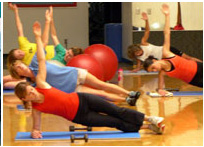
Wouldn't it be fabulous to wake up on your own, feeling refreshed every morning? I wish. Unfortunately the demands of work, children, or daily stress prevent many people from getting the required 7-8 hours of sleep a night. Lack of sleep disrupts your mood, lowers your immunity and is closely linked to obesity and other health problems.
Consistently sleeping less than 7 hours per night increases sympathetic activity and evening cortisol production. Individuals with higher levels of cortisol, otherwise known as the "stress" hormone, intake more food and accumulate more abdominal fat than individuals with healthy cortisol levels. In addition, sleep deprivation decreases leptin levels. Leptin is released from fat cells and sends messages to our brain that our energy levels are in balance. Therefore, decreases in leptin trigger us to eat more to replenish energy stores. Finally, sleep restriction increases ghrelin levels, the "hunger" hormone.
The rise in sympathetic activity and hormone imbalances that result from sleep deprivation ultimately interfere with glucose utilization. By lowering levels of insulin secretion and promoting the hunger response in the brain, weight gain is inevitable. In turn, increased waking time has been linked to damaging behaviors such as a sedentary lifestyle and constant snacking.
It is easy to see why chronic sleep restriction can lead to obesity but what can we do to ensure we get 7-8 hours of sleep every night? Here are recommendations from the experts:
- Go to sleep and wake up at the same time every day. Our bodies easily fall into a routine and by maintaining a consistent bed time, we will be more likely to fall asleep quickly.
- Avoid alcoholic drinks that interfere with REM sleep and cut back on caffeine, nicotine and chocolate after noon.
- Be sure your medications are not keeping you awake. Especially prescription asthma or blood pressure medications or herbal cold medicines.
- Get enough sunlight. Daylight plays a huge part in regulating our sleep cycle. Be sure you are getting at least 30 minutes/day.
- Establish a relaxing nighttime routine. Whether it be taking a hot bath before bed or reading yourself to sleep, a relaxing routine cues your body to sleep.
- If you can't sleep, tossing and turning won't help. If you lay awake for longer than 20 minutes, get up and do something relaxing (not work) rather than lay awake, focusing on your insomnia.
We all know the demands of life can sometimes sap our needed sleep. A night or two of sleep restriction is nothing to worry about. However, if you have been consistently suffering from insomnia and nothing seems to help, it is time to see your doctor. Sleep tight!
This article was adapted from Chronic Sleep Restriction, IDEA Health and Fitness Journal; September 2010 and MedicineNet.com, Sleep.











